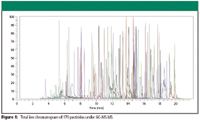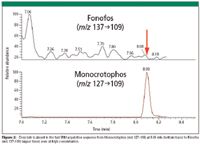Fast Multi-Residue Pesticide Analysis Using Triple Quadrupole GC–MS-MS
The Application Notebook
H-SRM provides excellent selectivity for accurate identification and quantification of pesticides in matrix, demonstrating high productivity for effective control at international maximum residue levels (MRLs).
H-SRM provides excellent selectivity for accurate identification and quantification of pesticides in matrix, demonstrating high productivity for effective control at international maximum residue levels (MRLs).
Currently, more than 300 regulated pesticides can be analyzed by gas chromatography–mass spectrometry (GC–MS) while a large group of highly polar pesticides is covered by liquid chromatography–mass spectrometry (LC–MS) methods (1). GC–MS analysis of multiple pesticides at the MRL becomes an increasing challenge for quality and governmental control strategies.
A particular challenge in the detection and quantification of a large number of pesticides in one run derives from the complex elution situation. Because many compounds partially or completely coelute, a high-speed analyzer is required to generate a sufficient number of data points. This ensures reliable integration of overlapping chromatographic peaks.
This application note provides the analytical methodology for a fast multi-residue pesticide determination using the unique capabilities of the Thermo Scientific TSQ Quantum GC™ triple quadrupole mass spectrometer for quantitation and confirmation of positive results. By taking advantage of the unique fast acquisition rate provided by the TSQ Quantum GC, the rapid analysis of multi-pesticide residues becomes routine in modern food safety testing labs and addresses the main challenges for this type of analysis:
a. Narrow GC peaks require fast MS acquisition rate to give sufficient data points for qualitative and quantitative analysis.
b. With multi-component methods the partial or complete coelution of components needs to be considered. The SRM transition speed needs to be fast enough to monitor many coeluting components while providing sufficient data points for reliable peak integration.
c. The multi-component method should include as many substances as possible, which requires the MS be capable of acquiring several hundred SRM transitions in a single run.
d. The MS method should require as few acquisition segments as possible for multiple targets due to the small changes in retention time that may occur in heavy matrix samples. This means the MS must be able to measure as many transitions as possible in one segment window without losing sensitivity.
e. Under these conditions, it is necessary to use short SRM dwell times and a very short interscan time.
f. When using short dwell and interscan times for targets generating the same product ions, "cross talk" must be safely prevented. "Cross talk" can lead to false positive results in sample analyses.
Experimental Conditions
The data acquisition method includes a total of 175 SRM transitions in a single 20-min run using the TSQ Quantum GC. The run was divided into 11 retention time windows (acquisition segments) with up to 25 SRM transitions in each. Dwell times of 25 ms were used to obtain good sensitivity and a fast data acquisition rate for the quantification. The Thermo Scientific TRACE GC Ultra™ gas chromatograph was used to provide fast chromatography, and the Thermo Scientific TriPlus™ autosampler configured for liquid injection was used for automated, productive sample introduction. A Thermo Scientific TRACE™ TR-5MS analytical column was used for chromatographic separation. The short column length (15 m) contributed to the fast GC run time and improved sample throughput. The SRM acquisition segments were primarily chosen to ensure that each window provided a comfortable setup of the compound list, with each component having a transition dwell time of 25 ms.
To streamline the data review and reporting process for multiple pesticides analysis, Thermo Scientific QuanLab™ Forms 2.5 software was used to provide productivity enhancements tailored to the workflow demands of the pesticides analysis laboratory. QuanLab Forms includes an integrated user interface for the management of the total list of pesticides, automated data review, customizable views, and versatile reporting formats.
Results and Discussion
A complete chromatogram demonstrating the complexity of the elution profile of 170 pesticides at 50 pg/μL is shown in Figure 1. The last peak elutes at 20 min. The 170 pesticides analyzed cover multiple compound classes; organochlorine, organophosphorus, carbamates, pyrethroids as well as triazine pesticides were analyzed using 175 corresponding SRM transitions.

Figure 1
"Cross talk" is described as a memory effect of the collision cell in a triple quadrupole mass spectrometer. In cases of cross talk, a signal for a pesticide compound not actually present in the sample would be seen as a false positive. With a total of 25 SRM transitions in the segment window from 5.97 to 8.27 min, the dwell times and interscan times are very short, which requires a fast scanning sequence with active cleaning of the collision cell before acquiring the next data set. Zero cross talk on the TSQ Quantum GC was demonstrated by acquiring two different SRM transitions of Monocrotophos (m/z 127>109) and Fonofos (m/z 137>109) which yields the same product ion of m/z 109 in the same segment window (Figure 2). This demonstrates the clear absence of cross talk, providing absolute certainty in the data with no false positive results.

Figure 2
Conclusion
The Thermo Scientific TSQ Quantum GC provides highest productivity for multi-residue pesticide analysis for effective control at the international MRL levels.
High sample throughput is demonstrated using a fast GC method. A total of 170 pesticide components were screened with high sensitivity on a TSQ Quantum GC in a single injection with an analysis time of only 20 min. Excellent sensitivity, selectivity, and flexibility were given by using up to 25 transitions in 11 retention time windows. False positive results due to cross talk were safely excluded even under fast acquisition cycles. The TSQ Quantum GC offers the potential to even further reduce dwell times without sacrificing the overall sensitivity, which would then allow the addition of more target pesticides as necessary. QuanLab Forms software provides a workflow-oriented format that allows analysts to easily create and manage methods, acquire samples, review results, and print reports.
Reference
(1) Ministry of Health, Labour and Welfare Japan, Department of Food Safety, "The Postive List System for Agricultural Residues in Foods," June 2006, see: http://www/mhlw.go.jp

Thermo Fisher Scientific, Inc.
355 River Oaks Parkway, San Jose, CA 95134-1991
tel. +1 800-532-4752; fax +1 561-688-8731

Separation of Ultra-Short and Long Chain PFAS Compounds Using a Positive Charge Surface Column
December 11th 2024A separation of ultra-short and long chain PFAS (C1-C18) is performed on a HALO®PCS Phenyl-Hexyl column along with a HALO®PFAS Delay column which demonstrates excellent retention for both hydrophilic and hydrophobic analytes.














